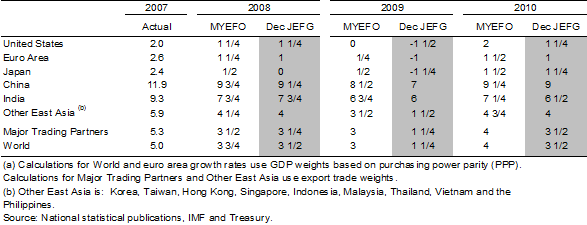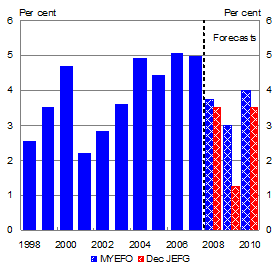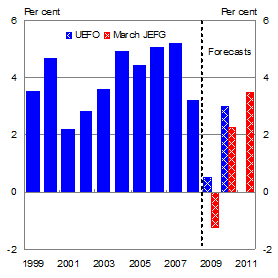Table 3: International GDP growth forecasts(a)

World outlook and risks
Global economic prospects have deteriorated further over the past month as the effects of the global financial crisis filter through more forcefully to the real economy. The financial crisis has undermined business and consumer confidence and has pushed many economies across the globe into recession. Over the past month, indicators of business confidence have fallen precipitously and consumer confidence remains low, suggesting that the slowdown already in train is set to intensify into the first half of 2009.
In recognition of the dramatic downshift in these sentiment indicators, as well as recent partial indicators of economic activity, growth forecasts for 2009 have been marked down for every country (Table 3). Global GDP growth is now expected to weaken from 3½ per cent in 2008 to just 1¼ per cent in 2009. In comparison to the MYEFO forecast, the 2008 growth forecast has been revised down by ¼ of a percentage point, while the 2009 growth forecast has been revised down by a far more substantive 1¾ percentage points (Chart 11).
The financial market turmoil that began in August 2007 morphed into a full-blown crisis during September and October of this year. The main catalyst for the dramatic intensification in financial market volatility was the collapse of US investment bank Lehman Brothers in mid-September.
Chart 11: World GDP growth

Source: IMF and Treasury.
Measures of global financial market stress spiked sharply in the days following this event. Central banks injected unprecedented amounts of liquidity into their financial systems and governments around the world implemented policies involving the recapitalisation of systemically-important financial institutions, depositor protection and support for interbank lending.
These extraordinary policy responses have led to a moderation in the extreme level of risk aversion that characterised financial markets in September and October, although the global financial system remains under significant stress and remains vulnerable to further disruptions. While indicators of stress in global money and credit markets have moderated recently, liquidity remains scarce as asset price deflation has caused financial institutions to write-down illiquid assets, hoard liquid assets and aggressively deleverage balance sheets.
The first phase of this financial deleveraging process, driven by the decline in both asset values and lending to borrowers at the risky end of the spectrum is currently well advanced. With global growth slowing sharply and financial conditions remaining difficult, there is a general consensus that much higher corporate default rates as well as higher losses on securities and loans will eventuate. Against this background, the capital positions of systemically-important financial institutions will continue to remain under pressure.
The global financial system will continue to face significant challenges over 2009. Policymakers will need to remain alert to the ongoing risks posed by further balance sheet adjustments in the financial sector, and also ensure that monetary and fiscal policies provide needed insurance against downside risks to the real economy.
While policymakers have reacted aggressively to the financial crisis, at this stage, it is too early to fully gauge the effectiveness of these measures. Efforts by policymakers to ease and contain the crisis in funding markets, and in the process minimise the adverse feedback loop between economic activity and financial market tightening, constitutes the key precondition for an eventual recovery.
Reflecting the sharp retrenchment in domestic private demand, and the potential for further slowing, governments around the globe have enacted substantial economic stimulus packages, and further packages, most notably in the US, are likely to be announced over the next few months. Coupled with this stimulus, central banks across the globe have delivered substantial monetary policy easing, and further easing appears likely, including through non-conventional means, such as quantitative easing.
As the world economy enters into a deep downturn, commodity prices have continued to retreat. From a peak of almost US$150 per barrel in mid-July, oil prices have plunged under the weight of collapsing energy demand and a far bleaker economic outlook, to be currently trading around US$43 per barrel. Together with the fall in other commodity prices, inflation is set to fall markedly in the period ahead.
While the forecasts are downbeat over prospects for 2009, the risk to growth still remain titled to the downside. If recent actions on the part of policymakers are ineffective, and should sentiment among firms and households remain at depressed levels, then global growth outcomes are likely to be downgraded further.
Should such a scenario unfold, then the risks to growth in 2010, where global and MTP growth is projected to rebound to 3½ per cent, would clearly be to the downside. However, despite the apparent rebound in growth in 2010, growth is only projected to grow modestly through late 2009 and into 2010, and notably, remain below trend for virtually all economies. Chart 12 illustrates this point, which shows that, over the forecast horizon, MTP growth is set to remain below levels achieved over the past few years. Therefore, embedded in these forecasts is only a gradual return to trend growth.
Chart 12: MTP GDP growth

Source: IMF and Treasury.
Country summaries
The US economic outlook has softened considerably since MYEFO, due to further financial market turmoil and worsening economic conditions. Given the bleak outlook, our 2009 forecast has been downgraded by 1½ percentage points to -1½ per cent, and our 2010 forecast by ¾ percentage points, to 1¼ per cent. Recent economic indicators, together with the National Bureau of Economic Research's announcement that the US recession began in December 2007, implies that this recession is going to be deep and protracted.
The labour market has continued to deteriorate, with payrolls falling sharply and the unemployment rate increasing. Consistent with this, consumers have cut spending severely, with consumption detracting significantly from growth in the September quarter and retail sales declining. Given that households in the US face rising cash flow and balance sheet strains due to falling house prices, weak equity returns, tighter access to credit and rising unemployment, consumption is expected to remain weak through most of 2009.
In the face of continued housing market weakness, residential investment is not expected to stabilise until the second half of 2009, at the earliest. Meanwhile, tighter credit conditions and weaker business sentiment are likely to restrain business investment into 2009.
While contracting domestic demand will constrain imports, the much weaker external outlook poses risks for exports contribution to GDP growth in coming quarters. Export growth is likely to soften in the wake of further notable output contractions expected in advanced economies and a stronger US dollar.
However, inflation risks have moderated, given weaker economic activity and lower commodity prices. Core inflation is expected to ease through into 2009 due to falling capacity utilisation and rising unemployment
. In December, the US Federal Reserve cut official interest rates, and established a target range for the federal funds rate of 0 to 0.25 per cent. The Fed also committed to keeping the Fed Funds rate at low levels for an extended period of time and to consider ways of using its balance sheet to further support credit markets and economic activity.
The outlook for China has continued to deteriorate since MYEFO as a result of the global slowdown. The Chinese economy is now expected to grow by 9¼ per cent in 2008 and 7 per cent in 2009, before recovering to 9 per cent in 2010. Slower global demand will put downward pressure on China's exports, while investment growth is expected to moderate due to a weakening property market. In 2010, exports and investment are expected to pick up, in line with a recovery in major trading partner growth.
Faced with a slowing economy, Chinese authorities have changed their policy stance to one of 'appropriately loose monetary policy' and 'proactive fiscal policy'. Chinese authorities have lowered reserve requirement ratios and aggressively reduced interest rates, reducing the 1 year nominal lending rate by a total of 189 basis points since September. Authorities have also introduced a substantial fiscal stimulus package of RMB 4 trillion (nearly US$600 billion), to be spent over two years although the true extent of new spending in theis package remain unclear. Nonetheless, the package should provide considerable support to China's investment growth, particularly in the second half of 2009 into 2010.
The Japanese economy has now joined a number of major economies in recession. Demand for Japanese exports has slumped in recent months, reflecting both a weaker external environment and the rapid appreciation of the yen, and business investment is falling sharply. Although Japanese banks and corporations have not been significantly affected by sub-prime losses, Japanese equity markets have experienced sharp falls, with negative flow-on effects for business and consumer confidence. Consumption continues to provide limited support to growth, despite moderating inflation.
Our GDP growth forecast has been lowered to zero per cent in 2008, down ½ of a percentage point since MYEFO. GDP is forecast to contract by 1¼ per cent in 2009, down 1¾ percentage points, reflecting a significant worsening in the expected depth and duration of the global slowdown. The Japanese economy is expected to post a gradual recovery from mid-2009 but to remain below trend in 2010.
The Indian economy continues to slow in line with slowing world growth. Industrial and service sectors, already labouring under high input costs, have now begun to suffer from significant declines in domestic and major trading partner demand.
Indian firms are also experiencing difficulty accessing sources of finance to fund their expansion as foreign investment had been retreating rapidly, reflected by sharp falls on India's major equity markets.
Our forecast for 2008 remains unchanged since MYEFO at 7 ¾ per cent, reflecting the slow petering out of India's strong domestic growth momentum. In 2009 and 2010 however, growth is set to slow sharply and has been revised down to 6 per cent and 6 ½ per cent.
Growth in the ASEAN-5 has deteriorated since MYEFO as waning external demand and the effects of the global financial crisis impact on the real economy. GDP is forecast to grow at 5½ per cent in 2008, before weakening to 3¼ per cent in 2009 as exports continue to ease in line with moderating major trading partner growth and investment slows due to increased borrowing costs and reduced access to funds from heightened risk aversion. Growth is expected to pick up towards the end of 2009 and into 2010, though is predicated on a recovery in the external environment.
Growth in the NIEs has deteriorated sharply amid a deepening global financial crisis. GDP growth is expected to weaken from 3 per cent in 2008 to ½ per cent in 2009. Given their close trade and financial integration with the rest of the world, the NIEs are expected to be hardest hit in Asia, and this is reflected in the 2½ percentage point downgrade since MYEFO for the 2009 growth forecast. Taiwan, Singapore and Hong Kong are expected to contract in 2009.
Exports have contracted substantially for each economy and forward-looking indicators also point to a marked slowdown in export momentum. The deterioration in the growth outlook has prompted governments to implement fiscal stimulus packages in an effort to bolster consumer and business confidence.
The outlook for the euro area has deteriorated significantly since MYEFO. GDP is forecast to grow by 1 per cent in 2008 before contracting by 1 per cent in 2009. The euro area is only expected to stage a modest recovery in the second half of 2009, conditioned primarily on improvements in financial markets conditions. The deceleration in growth is expected to be led by business investment, particularly as export growth weakens in line with slowing world demand. Consumption growth is expected to remain subdued reflecting a fall in confidence, deteriorating employment prospects and a rise in household savings. Growth is only projected to reach 1 per cent in 2010.
Growth prospects for the UK have also deteriorated markedly. GDP is forecast to grow by ¾ per cent in 2008, contract by 1½ per cent in 2009 before recovering to grow by 1 per cent in 2010. The slowdown in 2009 will be broad based, though is expected to be led by deceleration in investment as a result of tighter credit conditions and lower internal and external demand.
The outlook for New Zealand has also been revised down. With the economy in recession for most of this year, annual average growth is expected to slow to ¾ of a per cent in 2008, and to be flat in 2009. While interest rate reductions and further tax cuts are expected to provide some support, the ongoing housing market correction, tight credit conditions and financial market strains continue to place significant pressure on household consumption, business activity and confidence, while the expected slowing of global growth has compromised earlier prospects of an export-led recovery in 2009.